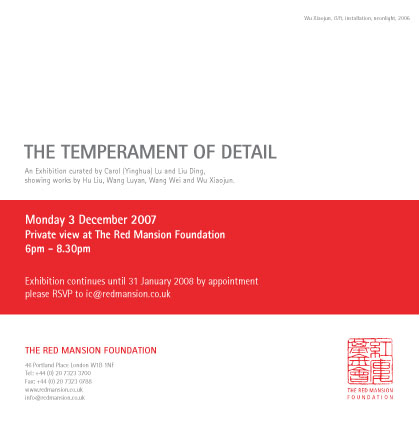
The Temperament of Detail
細節的氣質
Curated by Carol Yinghua Lu and Liu Ding
策展人:盧迎華、劉鼎
Artists: Hu Liu, Wang Luyan, Wang Wei, Wu Xiaojun
參展藝術家:胡柳,王魯炎,王衛,吳小軍
Dates: December 3, 2007 – January 31, 2008
2007年12月3日 – 2008年1月31日
Organizer: The Red Mansion Foundation, London, UK
Venue: The Red Mansion Foundation, 46 Portland Place, London W1B 1NF
www.redmansion.co.uk
地點:英國倫敦紅樓基金會
The Temperament of Detail
繼今年九月份由嚴培明策劃的開幕展成功舉辦之後,紅樓基金會邀請盧迎華和劉鼎在位於倫敦市中心的新空間策劃組織“細節的氣質”,一個由四位中國藝術家參展的當代藝術展。這個展覽試圖通過一個不同以往的全新視角呈現中國當代藝術創作的另一面,既藝術家對藝術語言本質的討論和實驗,不同於以往西方觀眾經常把中國當代藝術理解為特有意識形態的體現,抑或對現存藝術體制的反抗的解讀 。
紅樓基金會是1999年成立的非盈利組織,旨在通過講座、展覽、紅樓藝術獎及建立橋梁項目等藝術交換項目來促進中英藝術交流。另外,紅樓基金會還協助策劃並資助了一系列有關中國當代藝術的重要展覽,諸如在倫敦巴特西電站、奧斯陸和北京三地舉辦的《中國電站展》,在泰特利物浦舉辦的中國當代藝術展《真事》,第52屆威尼斯雙年展的中國館展覽,以及第十屆伊斯坦布爾雙年展。
開放時間:
請提前預約:2007年十二月三日 – 2008年一月三十一日 紅樓基金會
地址:46 Portland Place
London W1B 1NF
電話:+44 (0) 207 323 3700
傳真:+44 (0) 207 323 0788

Carol Yinghua Lu & Liu Ding
The research we undertook to formulate this exhibition was an incredibly fascinating journey of discovery of artistic ambitions and an intriguing investigation into the formal and conceptual strength in art practice. This is part of an ongoing attempt to invigorate the discussion of the aesthetic and conceptual meanings of art. Such a discussion is particularly pertinent in China today considering the fact that the dominant art historic narratives and existing art systems tend to emphasize and recognize the more utilitarian assets of art practice, such as the social or political motivations, the shock value or commercial worth, and the anti-establishment or subversive nature of artworks. These concerns, although valid, tend to eclipse some of the more fundamental topics about art making and contribute little to the development of the language of art itself.
In exhibitions of Chinese contemporary art inside and outside of China, most works are overridden by too strong a desire to address a variety of social, political and personal matters, while these reflections appear to be too simple, direct and formulaic translations of the reality itself. These interpretations of the reality, often without detailed investigation and thoughtful analysis and regulated by the limited experiences of human beings, are inevitably paled in comparison with the absurdity and intensity of the reality itself. As a result, the necessity of their existence can only be validated by the context of art, while such isolation makes their arguments seem even more superficial and disengaged. More often than not, the aspirations for moral discussions and narratives in art also help disguise an artist’s weaknesses, and a lack of sensitivity towards the magical potential of art to transform something mundane, something common, something out of an everyday context into the realm of art.
In China, the decades from the 1940s to the end of the 1970s, a time when art was subordinated to political needs, shaped a deep-rooted functionalist approach to how art is produced and viewed, the residue of which can still be felt today. Art writers tend to focus on the interpretation, and sometimes over-interpretation of the ideological proposition of a work, while hardly attending to the artistic attributes and rhetoric of art. There is almost no critical engagement with the aesthetics and conceptuality of art. The full significance of the romantic, the sublime, the poetic, the emotional, and the ambient horizon in art is yet to be identified and acknowledged.
The battle to regain the autonomy of art started as early as October 1980, when French-trained painter Wu Guanzhong, published his article “on Abstract Beauty” in Art Monthly (Issue no 10, 1980), arguing that abstract beauty is the core of formal beauty and people instinctively love abstract and formal beauty. His view sparked the first nation-wide debate among art circles about abstract art and, more significantly about the formal element of art after the end of the Cultural Revolution. The 80s saw an unstoppable wave of earnest experiments with styles and practices derivative from Western modern art movements, usually out of their original contexts yet adapted and enriched by the local background of their adopted home turf and the knowledge and experience of Chinese artists. In parallel with depictions of their immediate reality, religious themes, and expressions of pent-up frustrations with the former decade of intellectual suppression, in the hope of searching for new spiritual outlets and releasing their emotive potential, a number of artists quietly embraced conceptual art to reflect critically on questions concerning individual experientialism to the formation of a new social system and social orders. This conceptual movement of a minority of Chinese artists however was and remains today marginalized and overshadowed by social and cynical realist paintings and political pop art supported and consumed by international cultural tourists and art speculators all through the 1990s till the present. Sporadic attempts at revitalizing the exploration of the inherent elements of art making throughout the 1990s, such as the post-sense sensibility group, all eventually became a formality over content, overrun by their rebellious passion and deprived of any of the original spirit that motivated them as they all evolved into collective movements.
The market boom and the immensity of resources that have become available in the art scene from the late 1990s to the present has curiously created an even larger bubble for art production. Some artists are concerned with filling up ever-expanding gallery spaces and meeting the orders of many collectors, allowing even lesser mental space to contemplate the primary concerns and mechanism of art.
It’s high time to give weight and consideration to the artist’s sensibility and subjectivity that grant the artwork a life of its own, in whatever form. It’s the aesthetic and conceptual ideas that compel an artist to work, provide a work its structure, and to a certain extent, bring it into existence. This is just the beginning.
|

